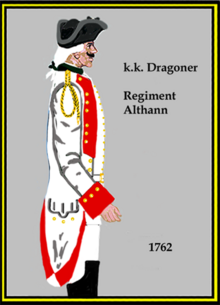"Althann" dragoon regiment
The regiment was a cavalry unit that was established in 1733 as a Kahory Dragoons for the imperial Habsburg army .
The following numbering was subsequently introduced for the system: 1733/2 (to Ticino ), Dragoon Regiment D XIII (to Bleckwenn ).
Until 1798, the regiments were named after their respective owners (who did not have to be the commanders).
Formation history
- 1733: According to the capitulation of November 4th of that year, eight companies were set up by Colonel Count Koháry at his own expense, the rest against receipt of advertising money, with a tribe of batches and long-serving men from some older regiments.
- 1768: the regiment was redissolved, the grenadier - company to the newly established 2nd Carabinier regiment (later Dragoons. 1 ), each one of the escadrons to the Dragoon regiments Savoy no. 13 , Batthyányi no. 10 , "Württemberg" No. 11 , Liechtenstein (dissolved in 1775) , Jung-Modena (1802 Dragoon Regiment No. 5 ) and Hessen-Darmstadt ( dissolved as Dragoon Regiment Toscana No. 4 in 1860 ).
Peace garrisons
- 1736–37 Transylvania
- 1740 Deés
- 1741–42 Debreczin
- 1747 Cremona
- 1748 Nagy-Tapolcsán
- 1750 in Neograd and Heves county
- 1753–56 Požega
- 1763 Vienna
- 1766–68 Güns
Regimental owner
- 1733 Colonel Andreas Count Koháry
- 1758 Field Marshal Lieutenant Michael Graf Althann
Regimental Commanders
- 1733 the owner, Colonel Count Koháry
- 1734 Colonel Franz Xaver Count Forgách
- 1739 Colonel Mladota von Solopisk
- 1742 Colonel Ludwig Graf Gross
- 1744 Colonel Philipp Christian Prince Löwenstein-Wertheim
- 1752 Colonel Gabriel Graf Keglevich,
- 1759 Colonel Caspar Freiherr Rummel von Waldau
- 1768 Lieutenant Colonel Gundacker von Wolff
Battle calendar
- 1734 After being ready for action , the regiment moved to Transylvania , but had no combat activity
- 1737–39 fighting in Wallachia
War of the Austrian Succession
- 1742 relocation to Bohemia , participation in the siege of Prague
- 1743 relocation to Italy
- 1744 Participation in the campaign against Naples
- 1745 Security and patrol services in Northern Italy, without combat activity
- 1746 fighting at Piacenza . Persecution battles against the retreating Spaniards
- 1747 Involved in the capture of Genoa (the Bocchetta)
- 1757 As a cover force in Vienna
- 1758 Participation in the battle of Hochkirch and the siege of Neisse
- 1759 Fighting in the Harsch corps in Upper Silesia
- 1760 Used in Loudon's army in the battles near Landshut and Liegnitz
- 1761 Security and patrol services in Silesia , without combat activity
- 1762 Battle near Peilau
Adjustment
- 1738: white skirt, red lapels
- 1757: dark blue skirt and trousers, ponceau red lapels
- 1765: red skirt, lemon yellow equalization , white trousers
- 1767: white skirt, ponceau red leveling, white trousers, white buttons
Regimental structure
The Austrian cavalry regiment initially consisted of four, later three divisions.
A division comprised three squadrons of two companies each in a cavalry regiment. The three divisions (battalions) of the regiment were (theoretically) led by the colonel, the lieutenant colonel and the major. This is where the name comes from:
- the 1st division was the colonel division
- the 2nd Division was the Lieutenant Colonel Division
- the 3rd division was the majors division
- the 4th division was the 2nd majors division
- the 5th division (if any) was the 3rd majors division
A company consisted of about 80 horsemen.
See also
literature
- Johann Christoph Allmayer-Beck , Erich Lessing: The KuK Army 1848-1914. Bertelsmann, Munich 1989, ISBN 3-570-07287-8 .
- Hans Bleckwenn: The Empress's Regiments: Thoughts on the Albertina Manuscript 1762 of the Military History Museum Vienna. In: Writings of the Army History Museum in Vienna. Volume 3: Maria Theresia - Contributions to the history of the army of her time. Graz, Vienna, Cologne 1967, pp. 25–53.
- Hans Bleckwenn: Horsemen, Hussars and Grenadiers. d. Uniforms d. emperor. Army on the Rhine 1734. Harenberg, Dortmund 1979. ISBN 3-88379-125-3 ; P. 17ff.
- Bertrand Michael Buchmann: Austria and the Ottoman Empire. WUV-Univ.-Verl., Vienna 1999, ISBN 978-3-85114-479-6 .
- Hermann Meynert: History of the KK Austrian Army, its formation and organization, as well as its fate, actions and campaigns, from the earliest to the present time. C. Gerold and Son, Vienna 1854. online at google books
- Osprey Military. Issue No. 271, reprint 1999.
- Austrian military history. Special volume 1997, Verlag Stöhr Vienna.
- Georg Schreiber : The emperor's cavalry. Austrian cavalry in 4 centuries. With a foreword by Alois Podhajsky . Speidel, Vienna 1967.
- Georg Tessin : The regiments of the European states in the Ancien Régime des XVI. to XVIII. Century. 3 volumes. Biblio, Osnabrück 1986–1995, ISBN 3-7648-1763-1 , p. 152ff.
- Alphons von Wrede: The history of the kuk Wehrmacht. The regiments, corps, branches and establishments from 1618 to the end of the XIX. Century. Vienna 1898–1905. Part III, Part 1 Cavalry, Part 2 Disbanded troops on horseback. Directory of regiment chiefs at the Wrede plant (PDF; 325 kB)

